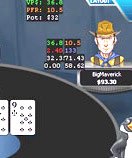Member Comments
No comments so far
 In an earlier article, we interviewed CardRunners instructor Tony “Tpiranha” Pirone about his focus on Limit Hold’em and, more specifically, use of a Heads-Up Display (HUD). For part two of this series, we tracked down Pirone’s CardRunners associate Brian “Ballzdeepx” Aleksa and asked him about using an HUD in Limit Hold’em games. His answers can be found below:
In an earlier article, we interviewed CardRunners instructor Tony “Tpiranha” Pirone about his focus on Limit Hold’em and, more specifically, use of a Heads-Up Display (HUD). For part two of this series, we tracked down Pirone’s CardRunners associate Brian “Ballzdeepx” Aleksa and asked him about using an HUD in Limit Hold’em games. His answers can be found below:
PSW: Tell us a little bit about the stakes you play. How are the Limit Hold'em games these days? Are there any weak spots or is it just all regulars?
Brian Aleksa: My normal game is anywhere between $15/$30 and $100/$200. I am extremely game selective. I think that is the single most important factor determining the survival or demise of winning players. I see games running every day that should absolutely not run. In such a game, there could be one guy who loses less than everybody's rake, and then everyone else is taking the worst of it or winning long-term at a very small margin with tons of variance. You will never see me in such a game.
Contrary to common belief, there are still good games. It is really a matter of having a flexible schedule and being able to play at almost any time of the day. Some pros who have families may not be afforded that luxury. They are often forced to play in games that are filled with other regulars because they feel like they should be playing every day. This kind of attitude brings nothing but variance, the need to grind rakeback to survive, and misery, in my opinion. People forget that it isn't 2005 anymore.
PSW: What HUD stats are most helpful to you in Limit Hold'em?
Brian Aleksa: I think it goes without saying that tightness/looseness and aggression are the most important stats. That's why these stats are in there by default. I don't think this requires any elaboration.
I keep my HUD kind of simple. In addition to the standard VPIP/PFR/AF, I use WTSD/Att to Steal/Fold BB/Continuation Bet on the Turn/Check-Raise the Turn. I have a couple of turn-specific stats because the turn is the street that has the most variation in strategy in good and bad players alike. Some good players love barreling the turn or check-calling the flop and check-raising the turn. Others don't. Some semi-bluff a ton, some don't. It's important to form your strategy based on this.
Fold BB to Steal/Att to Steal are also very important in Limit Hold'em. Surrendering 0.5 BB is a big deal. If someone surrenders their BB too often, it can be correct to open with 100% of your range. If someone attempts to steal too little or too much, the strategy can vary a lot as well. I like to know the kind of range my opponent needs to put up a fight in their BB and figure out what kind of range I need to show up armed with.
Additionally, knowing an opponent's Att to Steal guides a lot of my 3bet decisions from the button and small blind. 3betting A-5o from the small blind against a button stealer can be a no-brainer against a certain type of opponent and an egregious error against a different kind.
PSW: If you use an HUD for No Limit games, how is that it any different? Do you depend more heavily on the HUD for Limit or can you still get reads on players?
Brian Aleksa: I only really play No Limit in tournament format. For that, I like to know how often my opponent continuation bets the flop as well as the turn. I also like to know how aggressive my opponent is on the river. In Limit, continuation betting the flop is standard close to 100% of the time and a lot of river value bets/bluffs are very clear.
This is not necessarily the case for No Limit tournaments. But, when playing tournaments, I would say that I expend a lot more effort watching how people are playing. This is because there are a lot more spots where people might slow play or design elaborate bluffs. This won't show up in stats and I need to know who these people are.
As far as using the HUD for Limit, it's kind of like riding a motorcycle with a helmet on. It feels safer and I can operate at higher speeds (or more tables for this sake of this torpid analogy). But the big caveat is that if you're using an HUD, never rely on it as a crutch. It doesn't tell you who is tilting or who is protecting a win in a bigger game. It doesn't tell the story of the nit who, on this particular night, has stumbled home from the bars to gamble it up. Only paying attention to the games you're playing in can enable you to notice these types of things. The HUD is supposed to aid your decisions, not make them.
Visit CardRunners today!
No comments so far